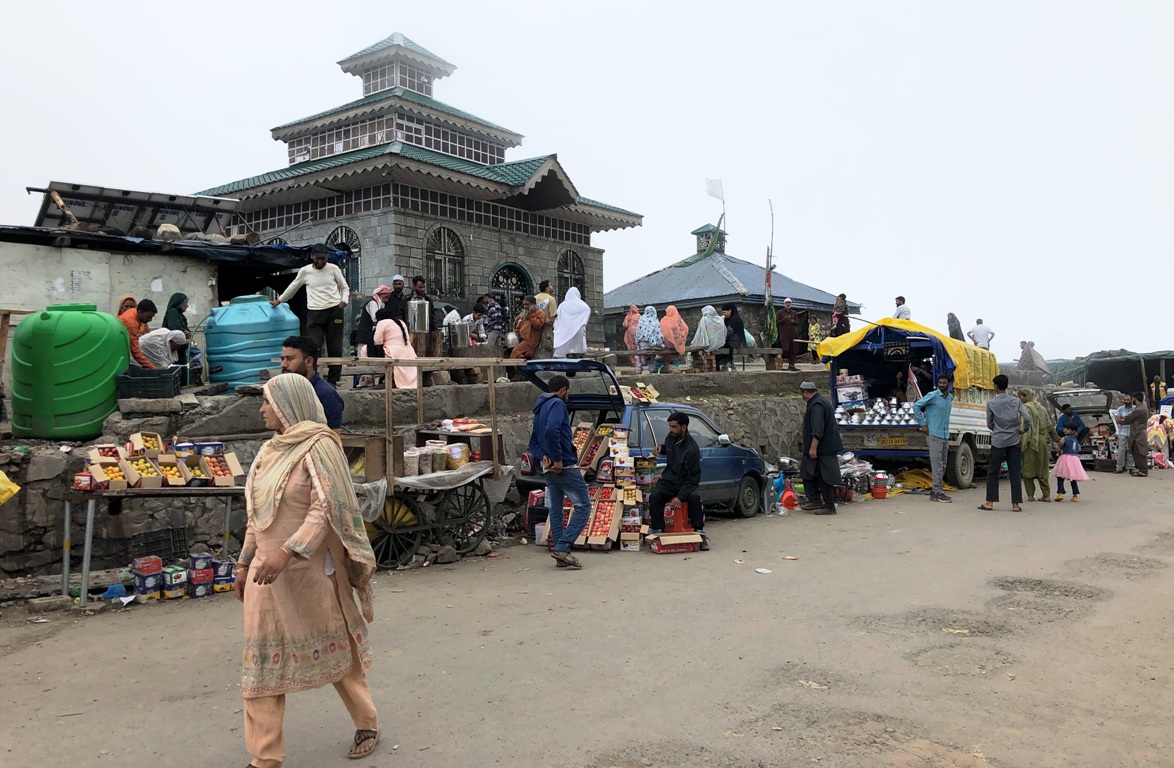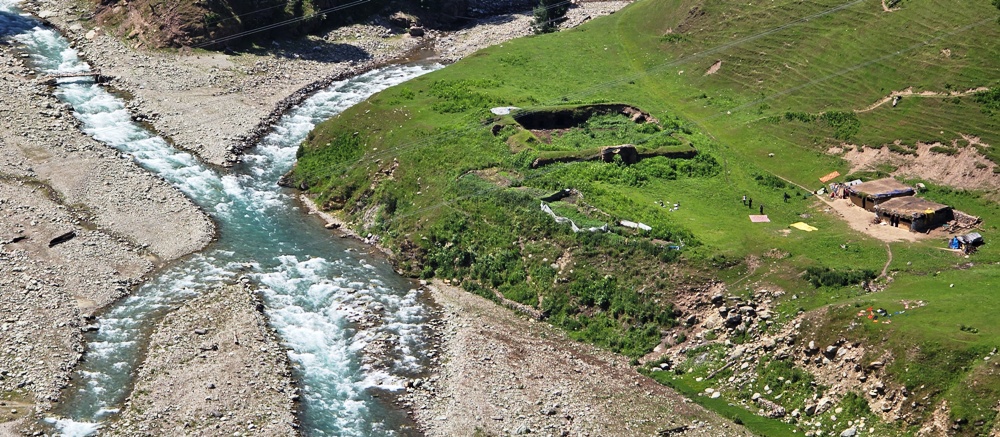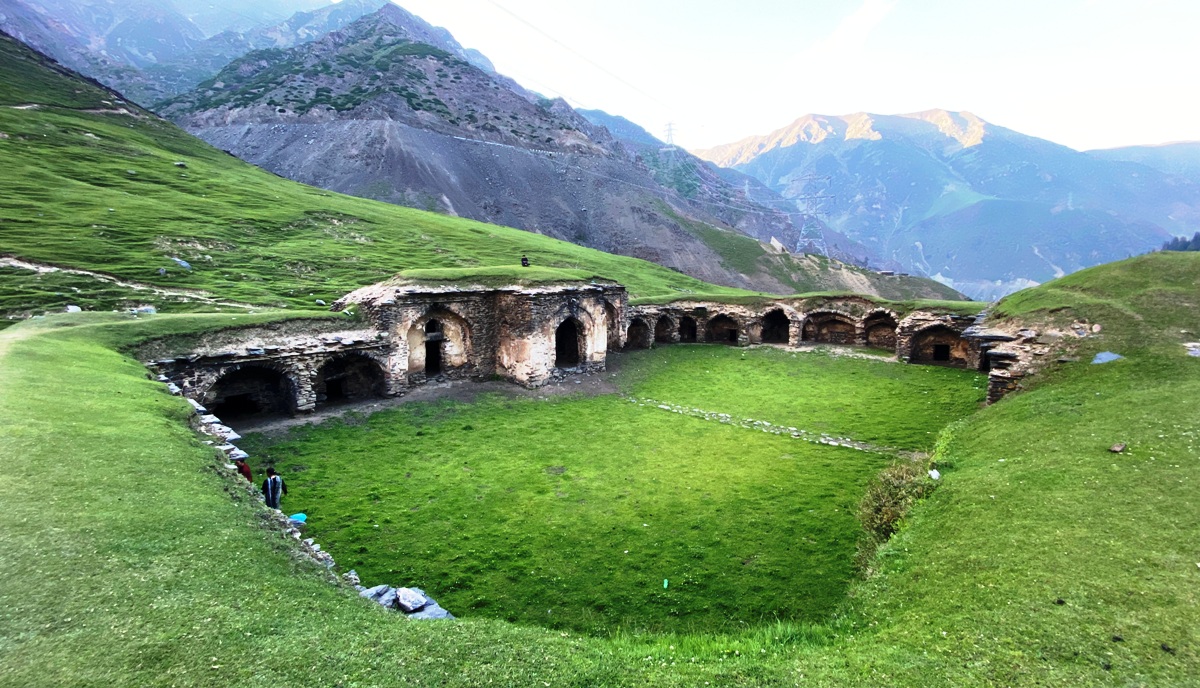Mughal Road which connects Kashmir with Pir Panchal Valley seems more of a heavenly tourism belt rather than a communication link. Humaira Nabi accompanied Iqra Akhoon on a long drive to Pir Ki Gali to write an exhaustive travelogue on a trek, people have fallen for in the last half of the millennium
Nestled within the enchanting landscapes of the Pir Panjal range, Pir Ki Gali is a picturesque and serene mountain pass that offers breathtaking views. Situated approximately 90 km from Srinagar, this pass lies at an elevation of 11400 feet above sea level, on the boundary between Poonch and Shopian districts.
This oxygen-depleted spot is an accessible space where one can walk with the clouds and understand the net difference between temperate and sub-tropical climates.
Pir Ki Gali is part of a historic route known to Kashmir as Shehr-ae-Namak, the salt highway. After the Mughals conquered Kashmir and made this trek their frequent route, it became the Mughal Road, especially after Emperor Jehangir frequently travelled on it in the early seventeenth century.
As the highest point of the Mughal Road, Pir Ki Gali is often referred to as the crown of the 240 km road that pierces the Pir Panjal range. The pass is surrounded by a beautiful valley of seven lakes, Panj Tarni meadow, Girjan Doke, Tata Kutti peak, and Chatta Pani.
The Shrine
Pir ki Gali is named after Sheikh Ahmed Karim, a Hindu saint who converted to Islam. Legend has it that he embraced Islam at the hands of Alamdaar-e-Kashmir, Sheikh Nooruddn Noorani.

Of tens of thousands of travellers who have crossed the pass in the last more than 500 years, Bernier Francios has left behind a slightly detailed paragraph. The French physician and traveller travelled with the caravan of Mughal Emperor Aurangzeb from Lahore to Kashmir in 1665. He has not named the “aged hermit” and has not offered any idea about his faith but Bernie has talked about the legends surrounding him.
Bernier has mentioned that the hermit has resided on the top of this mountain ever since the time of Jehanguyre (Jehangir). “Of his religion everybody was ignorant; but it was said that he brought miracles, caused strange thunders, and raised storms of wind, hail, snow, and rain,” he wrote. “His white and uncombed beard was extremely long and bushy; he had somewhat of the savage in his aspect, and was haughty in his manner of asking alms. He permitted the people to drink water out of some earthen cups placed in rows on a large stone, making signs with his hand that they should not stop, but hastily leave the summit of the mountain.”
In Travelers In The Mogul Empire, Bernier offers interesting details about this hermit. “The old man was also very angry with those who made a noise,” he recorded. “After I had entered his cave, and softened his countenance by means of half a roupie, which I humbly put in his hand, he informed me that noise made there stirred up the most furious tempests imaginable. It was wise in Aureng Zebe, he added, to be guided by his advice, and to order the army to pass with stillness and expedition. His father, Chah Jehan (Shah Jehan), always acted with the same prudence; but Jehan Guyre (Jehangir) having upon one occasion derided his counsel, and, notwithstanding his earnest remonstrance, having ordered the cymbals to be beaten and the trumpets to be sounded, narrowly escaped destruction.!”
It is now known that it was Sheikh Ahmed Karim, whose shrine is managed by a devotee from Poonch and Heerpora. Pir KI Gali falls in Poonch district but is close to Shopian so people and professionals from both sides work on the spot.
The annual Urs at this shrine is celebrated every year during the harvest season and people in large numbers from Rajouri, Poonch, and Shopian participate in this. Urs is sort of an anniversary of some revered person’s death or birth.

Apart from space, what remains constant is the Langar, a community kitchen. “Earlier, this Langar used to offer Meanchir Chai with Postul and Yangratch roots, all collected from the wild,” Abdul Sattar Bhat, one of the two custodians, who runs the community kitchen and takes care of the shrine, said. “Now these items are very expensive and are used in the ayurveda medicine. We now offer normal Sheer Chai and Sattu.” Bhat has been operating the shrine langar for the last half a century. He claims it has been operating since the middle of the fourteenth century.
The vehicles stop here and people pay obeisance at the shrine. The locals from Shopian and Rajouri have set up numerous small stalls where they sell a variety of food items and other goods. This modest market serves as a source of Tabaruk for visitors, who purchase items here as sacred gifts to bring back to their loved ones. However, the scenic spot that offers a glimpse of a tribal market has serious issues – there are no bathroom facilities, no waste management system and no basic healthcare facility. Though authorities have put up some mobile urinals, these are either always inundated with users or simply too unclean worth use.
Fascinating Spots
While halting at the Pir Ki Gali offers the satisfaction of reaching a fascinating destination, travelling to the spot is reliving a history. The road from Shopian town to Pir Ki Gali winds through picturesque villages like Padpawan, Heerpora, and Dubjan. These villages are nestled along the banks of the clear Rambi Aara River, which flows at the base of the majestic Pir Panchal range. The route also passes through the Hirapur Wildlife Sanctuary, which is home to the rare and endangered Markhor wild goat species. From Poonch, the road leading to Pir Ki Gali passes through scenic places like Buffliaz, Behramgala, Chandimarh, Dugran, Pushana, Chatta Pani and Mansar.
Heerpora is the last permanent habitation on the road from the Kashmir side. Certain writers believe that Hindu king Avantivarman (855-883) had built a watch post and named it Sura Pura, which corrupted and became Hura Pura. Later, Sultan Zainul Abideen Budshah (1395-1470) raised a gate and named it Illahi Darwaza, besides setting up a labourer colony for labourers from Bimbergali and Rajouri.
It has always remained the gateway of Kashmir till the Jhelum Valley Road (Srinagar-Muzaffarabad) and the Banihal Cart Road (Srinagar-Jammu) devoured Mughal Road’s significance in the last century.
It was this village where the dignitaries were formally received by the Kashmir elite. Most of the transporting, camping and labour that the visiting dignitaries, tourists and rulers would require would start from here. Historically, it has remained the transportation hub managing almost the entire requirements of the visiting caravans between Heerpora and Khanabal, where they would get into the boats. The majority of the population in this village would be called Sawaar, a Persian and Urdu name for a horse rider.
At some point in time, there was a Sarai in Heerpora, which has now been obliterated from the spot and small ruins can be traced.
After the Mughal Road was formally opened, the village has completely changed. With apple orchards funding its growth, the residents have converted the entire road stretch into a bustling market, dominated by eateries.
Doubjen has remained famous for its Sulphur springs and easy access to the deep meadows of Rai Neour. It is now being seasonally inhibited by herdsmen who operate from traditional dhoks and leave home in late autumn. Apart from grazing herds, the nomadic tribes, mostly from Rajouri and Poonch sell a lot of dairy products including the famed Moushe Kraid, the butter bread.
Two Interesting Spots
There are two spots which are part history part myth. One is the Haes Van (Hasti Van) and another is Qaroonun Khazaneh. While the latter faces the main highway, the Elephant Forest is slightly deep into the Pir Panchal but a peak is visible.
There is a mountain that is always witnessing soil erosion. During the day, small particles like tiny husk dots fly in the air and later settle on the same peak. This has given this small mountain identity of Qaroonun Khazana, the treasure of Croesus, a super wealthy man who lived in the era of Moses. Legend has it that treasure gets converted into dust to suggest that money does not matter always.
However, the Hasti Van is linked to history. It is the same peak that is recorded in history. Mehr Kul (Meihirakula) who ruled Kashmir in the sixth century, once had his elephant slipping into a gorge. As the animal was bellowing, a trumpet injured elephants resort to, the ruler liked it. He was so fascinated by the sound that he pushed too many of his elephants into the gorge! In Rajatarangni, Kalhana terms the spot as Hanstvanj.
During the Mughal era, the trek was too crowded when the mighty kings would move. When Bernier accompanied Aurangzeb, has recorded that two private camps would move. One was an advance party that was called Peiche-kanes, a house that proceeds. Every camp would require more than sixty elephants, 200 camels, 100 mules, and one hundred men-porters. Elephants would take bulky tents with their heavy poles.
It was during the entry into this stretch, Bernier recorded that an accident took place. The king was ascending the Pire Panchal mountains and was followed by a long line of elephants, upon which sat the ladies. “The foremost, appalled, as is supposed, by the great length and acclivity of the path before him, stepped back upon the elephant that was moving on his track, who again pushed against the third elephant, the third against the fourth, and so on until fifteen of them, incapable of turning round or extricating themselves in a road so steep and narrow fell down the precipice,” Bernier recorded as an eye witness to the incident. “Happily for the women, the place where they fell was of no great height; only three or four were killed; but there were no means of saving any of the elephants. Whenever these animals fall under the tremendous burden usually placed upon their backs, they never rise again even on a good road. Two days afterwards we passed that way, we observed that some of the poor elephants still moved their trunks.”
The Mihirkula moment of Aurengzeb is recorded in history and gives a chain of meadows its name – the Hasti Van, an elephant forest. Kashmir has no elephants.
The Lal Ghulam
The stretch between Dubjan and Sukh-Sarai is peculiarly named Lal-Ghulam. It has multiple legends associated with its name. The local nomadic community believes that this stretch posed a tough challenge for Mughal builders, as their constructed portion would skid off every night. Believing that the talukdaar (the guarding spirit) of the area was not favouring the construction of the road, a sacrifice was offered to the ghost. A Lal-named person’s head was chopped off, placed on the slope, and stones piled up on it. From that day, the track never slid off and was named after him.
Another legend suggests that a man-eater named Lal Ghulam resided in the area when Ali Mardan Khan started working on the Sarai. The inhabitants told Ali Mardan that the place was haunted by a man-eater, Lal Ghulam, who threw everyone to their death from the peak and later ate them. However, Ali Mardan was said to be strong enough to bust the fear psychosis created by Lal Ghulam.
Some believe that Lal-Ghulam was one of the engineers who worked on the Mughal road and was later killed by Ali Mardan Khan for reasons unknown. It is also said that he was a ‘slave’ engineer who served the Mughals.
Twin Sarais
Mughals had created a chain of Sarais, inns, where their caravans would rest. After passing the Dubjan Bridge, which stands beside the Dubjan waterfall, the area below the hill embraces two historic Mughal Sarai- Sukh Sarai, and Aliaabad Sarai.
These Sarai’s are part of a historic network of 14 halting stations built along the Mughal Road that once connected Lahore and Srinagar. Overseen by Ali Mardan Khan, an Iranian engineer renowned for his expertise, these way-stations were constructed using a combination of round and flat stones, baked bricks, lime mortar (Choona Surkhi), and mud. Despite their historical significance, these rest houses are infrequently visited due to the arduous paths leading to them.
Sukh Sarai is located near Dubjan and is approximately 3 km away from Pir Ki Gali. This sarai sits down the hill at the confluence of two rivers – the Pir Panjal Nallah and the Nandansar Nallah, where they form the Rambara River that passes through Shopian periphery and gets into Pulwama. The Sarai is said to have been built by Emperor Akbar.
The Aliabad Sarai is believed to have been built by Emperor Jahangir towards the end of the sixteenth century. While both of these sarai are now in a state of disrepair, they still stand as an example of the great Mughal Architecture.
Reaching Sukh Sarai requires a challenging trek of over two kilometres through steep, rugged terrain, taking more than an hour. In contrast, while the trek to Aliabad Sarai is shorter, it is even steeper. Nevertheless, Aliabad Sarai remains in significantly better condition than Sukh Sarai. While the outer boundaries of Sukh Sarai have withstood the test of time, Aliabad Sarai features several internal cells and rooms that, although weathered and worn.

The Breathtaking Road
The road then gently winds its way upwards, ascending to the ethereal heights of Pir Ki Gali, an enchanting realm often cloaked in a veil of dense clouds. It feels as though one is journeying through the sky, with a cold breeze whispering secrets of the mountains. The weather here is highly unpredictable, changing within minutes.
While the winters are extremely cold, the summers offer a pleasant respite, with temperatures at Pir Ki Gali being at least 10 degrees cooler than in Srinagar. This temperature difference attracts tourists to the place during the summer months.
The green meadows on both sides of the road, perched high above the tree line, are expanses of open beauty. Despite the absence of trees, they remain breathtakingly picturesque. The lush greenery, dotted with shepherds and their sheep, appears as if stars are twinkling in a verdant sky from a distance.
The nomadic Gujjar Bakerwals community returns from the plains in April, their houses built entirely from stones. Houses are built from what is available there, with no trees they rely on stones which are abundantly present near the bank of Ranbi Aar and Dubjan waterfall. These stone houses blend seamlessly into the rugged landscape. These single-room houses are divided to accommodate both the families and their cattle, reflecting a harmonious coexistence with nature.
The Other Side

There are various other spots on the road on the other side of the pass as well. In the Kashmir context, the Mughal era is dominated by the love that Jehangir and his empress Noor Jahan showered on each other and Kashmir during their frequent Kashmir forays. Unlike Akbar who visited Kashmir thrice, Jehangir, his son, spent 13 summers in Kashmir. He used Mughal Road 11 times for Kashmiri travels. He eventually died on his way out from Kashmir near Rajouri in 1627, at Chingus Sarai, which had been built on his orders by Iranian engineer Ali Mardan Khan.
It is said that Noor Jehan buried Jehangir’s internal organs, to prevent decomposition, without declaring his death till his body reached Lahore, where it was laid to rest.
There is a famous spot called Noori Chamb, almost 10 km short of Bafliaz. Chamb is a Kashmir word which means slope of a hill or a mountain. At the headwaters of the Poonch River, this glacier-fed waterfall looks like a milky stream from a distance. Legend has it that the most powerful Mughal queen used to frolic under the fall and wash away the grimy dust of the plains during her arrival. Jehangir would often use a strategically placed mirror to keep a lusty eye on her under the waterfall while he merrily bubbled away on his aromatic hookah. A drunkard, Jehangir was a huge opium user.


